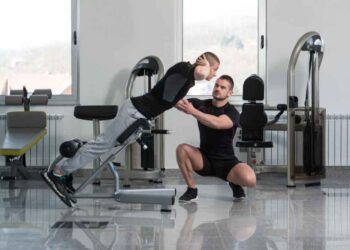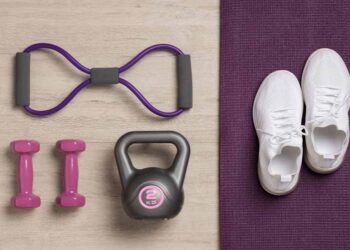Are you looking to elevate your leg workouts and achieve enviable lower-body strength? Look no further than lunges! This versatile exercise not only sculpts and tones your legs, but also improves overall fitness and athletic performance. Whether you’re a beginner or an experienced fitness enthusiast, lunges offer a wide range of benefits and variations to suit your needs. So, are you ready to lunge into strength and transform your legs with each step?
Key Takeaways:
- Lunges are a fantastic exercise for sculpting and toning your legs while improving overall fitness.
- They target multiple muscle groups in your lower body, including the quadriceps, hamstrings, glutes, and calves.
- There are various types of lunges, such as walking lunges, static lunges, and more, allowing you to add variety to your routine.
- Proper form and technique are essential to maximize the benefits and prevent injury while performing lunges.
- By incorporating lunges into your fitness routine, you can achieve stronger, more defined legs and enhance your athletic performance.
Benefits of Lunges
Lunges offer a range of benefits for your body. One of the notable advantages is weight loss. By incorporating lunges into your workout routine, you can target the large muscle groups in your lower body, leading to increased calorie burn and fat loss.
In addition to weight loss, lunges contribute to improving balance and stability. These exercises activate your stabilizing muscles, helping you gain control and coordination. By consistently performing lunges, you can enhance your body’s alignment and symmetry. They assist in correcting imbalances and misalignments, resulting in improved posture and overall body alignment.
Furthermore, lunges strengthen your core and back muscles. By engaging these muscle groups, you can develop a strong foundation that supports better posture and stability. This improvement in muscle strength contributes to easier and more efficient everyday movements, making activities like lifting, bending, and walking feel more effortless.
In summary, the benefits of lunges include weight loss, improved balance and stability, enhanced alignment and symmetry, and better posture. By incorporating lunges into your fitness routine, you can experience these advantages and take significant strides towards a stronger, healthier body.
Different Types of Lunges
There are various types of lunges that you can incorporate into your workout routine. Each variation targets different muscle groups and adds diversity to your training sessions.
1. Stationary Lunges
Stationary lunges are the foundation of all lunge variations. They primarily target the glutes, quadriceps, and hamstrings. To perform stationary lunges, start by placing one foot forward and the other foot back, keeping both feet hip-width apart. Lower your body by bending both knees until the front thigh is parallel to the floor. Push through the front heel to return to the starting position. Repeat on the other side.
2. Side Lunges
Side lunges engage the inner and outer thighs while incorporating lateral movement. Stand with your feet wider than hip-width apart. Shift your body weight to one side and bend the knee of that leg while keeping the other leg straight. Lower your body until the bent knee is at a 90-degree angle. Push through the heel to return to the starting position. Repeat on the other side.
3. Walking Lunges
Walking lunges help improve overall stability, core strength, and range of motion. Begin by taking a step forward with one foot, lowering your body into a lunge position. Push off the front foot and bring the back foot forward, repeating the movement. Continue alternating legs as you walk forward.
4. Reverse Lunges
Reverse lunges are suitable for individuals with knee concerns or difficulty balancing. They provide more stability compared to forward lunges. Start by stepping backward with one foot, lowering your body into a lunge position. Push through the front heel to return to the starting position. Repeat on the other side.
5. Twist Lunges
Twist lunges add a rotational component that activates your core and glutes more deeply. Begin with a forward lunge, then rotate your torso towards the bent knee while keeping your hips stable. Return to the starting position and repeat on the other side.
6. Curtsy Lunges
Curtsy lunges specifically target the glutes, hip adductors, quadriceps, and hamstrings. Start by crossing one leg behind the other, mimicking a curtsy motion. Lower your body until the front thigh is parallel to the floor. Push through the front heel to return to the starting position. Repeat on the other side.
7. Lunges and Squats
Lunges and squats are both effective lower body exercises that can be incorporated into your routine to work your muscles in different ways. Squats primarily target the glutes, quadriceps, and hamstrings, while lunges provide a greater emphasis on single-leg strength and stability.
By incorporating these various lunge variations into your fitness routine, you can challenge your muscles from different angles and achieve a well-rounded lower body workout.
| Type of Lunge | Main Target Muscles |
|---|---|
| Stationary Lunges | Glutes, Quadriceps, Hamstrings |
| Side Lunges | Inner Thighs, Outer Thighs |
| Walking Lunges | Multiple Lower Body Muscles |
| Reverse Lunges | Glutes, Quadriceps, Hamstrings |
| Twist Lunges | Core, Glutes |
| Curtsy Lunges | Glutes, Hip Adductors, Quadriceps, Hamstrings |
| Lunges and Squats | Glutes, Quadriceps, Hamstrings |
Muscles Worked During Lunges
Lunges are an excellent compound exercise that engages multiple muscles in the lower body, making them a staple in any leg workout routine. By targeting specific muscle groups, lunges help build strength, increase flexibility, and improve balance.
The main muscles worked during lunges include:
- Quadriceps: Located in the front of the thighs, the quadriceps are the primary muscle group targeted during lunges. They are responsible for knee extension, helping you power through the movement.
- Gluteus Maximus: The largest muscle in the buttocks, the gluteus maximus plays a crucial role in hip extension during lunges. It helps you stabilize and propel your body forward or backward.
- Adductor Magnus: Found in the inner thigh, the adductor magnus assists in hip adduction during lunges, ensuring proper alignment and stability.
- Hamstrings: Situated at the back of the thighs, the hamstrings play a significant role in knee flexion while performing lunges. They work alongside the quadriceps to control movement and maintain balance.
- Gluteus Medius: Located on the side of the hips, the gluteus medius helps stabilize the pelvis and allows for proper alignment during lunges. It also contributes to hip abduction and rotation.
- Calves: The calf muscles, including the gastrocnemius and soleus, provide support and assist in maintaining balance during lunges.
- Core Stabilizers: Although lunges primarily target the lower body, they also engage the core stabilizers, including the abdominals and lower back, to maintain proper posture and balance throughout the movement.
Each type of lunge variation may target these muscles differently based on the angle and range of motion involved. It’s essential to perform lunges correctly and maintain proper form to effectively engage and activate these muscles.
Image: Muscles worked during lunges
Now that you know which muscles are involved in lunges, let’s explore how to perform them correctly in the next section.
How to Perform Lunges Correctly
Performing lunges with proper form is crucial to maximize their benefits and prevent injury. Follow these steps to ensure you are executing lunges correctly:
- Start by standing with your feet hip-width apart.
- Take a step forward or backward, depending on the lunge variation, while keeping your chest lifted and core engaged.
- Bend your knees to lower your body until both knees are at a 90-degree angle.
- Make sure to keep your front knee aligned with your ankle and avoid letting it extend past your toes.
- Push through your heel to return to the starting position and repeat on the other side.
“Proper lunge form involves maintaining proper posture and focusing on engaging the targeted muscles throughout the movement.”
Remember, maintaining good posture throughout the lunge is essential. It helps target the correct muscles and prevents strain on your joints. Keep your chest lifted and your shoulders relaxed while performing the exercise.
By following these steps and paying attention to your lunge technique, you can get the most out of your lunges and achieve optimal results.
Tips for Perfecting Your Lunge Form
- Keep your core engaged throughout the movement to maintain stability.
- Focus on pushing through your heel as you rise back up to the starting position.
- Keep your gaze straight ahead to maintain balance.
- Start with bodyweight lunges before progressing to weighted lunges.
Remember, practice makes perfect. Take the time to master your lunge form, and you’ll reap the rewards of this powerful lower body exercise.
Incorporating Lunges Into Your Fitness Routine
If you’re new to lunges, it’s important to start with modified versions or bodyweight lunges to gradually build strength and proper technique. This allows your muscles to adapt and reduces the risk of injury. As a beginner, you can focus on mastering the fundamental lunges before progressing to more challenging variations.
Aim to include lunges in your fitness routine at least two times per week. Consistency is key for seeing results and improving your technique. Incorporating lunges into your workouts will target and strengthen your lower body muscles, helping you achieve your fitness goals.
The number of sets and repetitions you perform will depend on your fitness goals and current fitness level. For beginners, it’s recommended to start with higher repetitions, typically ranging from 12 to 20 lunges per set. This repetition range helps improve form, muscular endurance, and overall conditioning.
As you become more proficient and your strength increases, you can progress to lower repetitions with more challenging weights. This rep range typically ranges from 6 to 12 lunges per set and focuses on building strength and muscle definition.
Progression is key in your fitness journey. It’s essential to challenge yourself and gradually increase the weight or intensity of your lunges as your body adapts. This ensures continuous progress and prevents your results from plateauing.
Remember to always prioritize proper form and technique during your lunges. It’s better to perform fewer reps with excellent form than to compromise your posture and risk injury with sloppy execution.
By incorporating lunges into your fitness routine and progressing at your own pace, you’ll be able to enhance your lower body strength, build lean muscle, and improve your overall fitness level.
Tips for Incorporating Lunges:
- Start with bodyweight lunges to master the form and improve stability.
- Gradually increase the weight or resistance as you become more comfortable and strong.
- Experiment with different lunge variations to target different muscles and add variety to your routine.
- Include lunges as part of a well-rounded lower body workout routine that also incorporates other exercises like squats and deadlifts.
- Listen to your body and rest when needed. Overtraining can lead to fatigue and injuries.
- Consult with a fitness professional if you have any specific concerns or questions about incorporating lunges into your fitness routine.
Remember, consistency and patience are key when incorporating lunges into your fitness routine. As you progress, you’ll notice improvements in strength, muscle tone, and overall athletic performance.
Conclusion
Lunges are a highly effective exercise for strengthening and toning your legs, improving balance and stability, and enhancing overall athletic performance. By incorporating different variations of lunges into your fitness routine and performing them with proper form and technique, you can maximize their benefits and achieve your desired results.
Remember to listen to your body, start at a comfortable level, and gradually progress as you become stronger. Consistency and dedication are key when it comes to reaping the rewards of lunges. Whether you’re a beginner or an experienced fitness enthusiast, lunges can help you transform your lower body and improve your overall fitness level.
So why wait? Start lunging your way to stronger legs, better balance, and improved athletic performance today. Add lunges to your workout routine and experience the incredible benefits they offer. Your legs will thank you!













